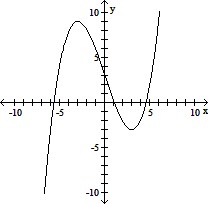Graph the function.f(x) = log5(x + 1)
A. 
B. 
C. 
D. 
Answer: A
You might also like to view...
Use the graph of the function f(x) to locate the local extrema and identify the intervals where the function is concave up and concave down.
A. Local minimum at x = 3 ; local maximum at x = -3 ; concave up on (-?, -3) and (3, ?); concave down on (-3, 3) B. Local minimum at x = 3 ; local maximum at x = -3 ; concave up on (0, ?); concave down on (-?, 0) C. Local minimum at x = 3 ; local maximum at x = -3 ; concave down on (0, ?); concave up on (-?, 0) D. Local minimum at x = 3 ; local maximum at x = -3 ; concave down on (-?, -3) and (3, ?); concave up on (-3, 3)
Solve the equation. +
+  = -1
= -1
A. - 
B. 5
C. 0
D. No solution
Find the 49th term of an arithmetic sequence with a first term of 4 and a common difference of 2. ?
Fill in the blank(s) with the appropriate word(s).
Solve.Racing cyclists use the function  to determine the maximum rate,
to determine the maximum rate,  , in miles per hour, to turn a corner of radius x, in feet, without tipping over. What is the maximum rate a cyclist should travel around a corner of radius 38 feet without tipping over? Leave the solution in simplified radical form.
, in miles per hour, to turn a corner of radius x, in feet, without tipping over. What is the maximum rate a cyclist should travel around a corner of radius 38 feet without tipping over? Leave the solution in simplified radical form.
A. 24 +  mph
mph
B. 24 mph
mph
C.  mph
mph
D. 4 mph
mph